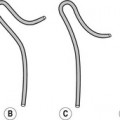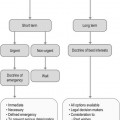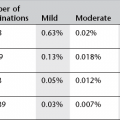Radionuclide imaging in oncology and infection
Positron emission tomography imaging
Positron emission tomography (PET) imaging is a technique used to detect and accurately stage malignant disease, to differentiate benign and malignant tissue, and to assess response to treatment. Until recently, PET imaging availability was restricted due to high capital cost and logistics of radiopharmaceutical supply. It uses short-lived cyclotron-produced radionuclides such as 18Fluorine, 11Carbon, 13Nitrogen and 15Oxygen with half-lives of 110, 20, 10 and 2 min respectively. 18Fluorine is the only one of these that has a half-life long enough to allow it to be produced off-site. This does permit 2-[18F]fluoro-2-deoxy-d-glucose (18F-FDG), the single most important PET radiopharmaceutical, to be used by sites without their own cyclotron.
The widespread acceptance of PET as a major advance is due to two major factors:
1. There is increased recognition in the literature of the role of the main PET tracer 18F-FDG, a glucose analogue that is taken up in tissue in proportion to cellular glucose metabolism. This is particularly useful for tumour imaging, since most tumours have increased glucose metabolism and will concentrate FDG. Malignant cells are characterized by increased glucose transporter molecules at the cell surface. FDG is phosphorylated by the enzyme hexokinase to a polar intermediate which does not cross cell membranes well and is, therefore, trapped in the cell. Hexokinase levels and activity are increased in malignant cells. The reverse reaction (glucose-6-phosphatase) is slow and the enzyme is commonly deficient in cancer cells.
2. Integrated PET CT scanners are now widely available and are the standard of care. These units have separate PET and CT scanners installed in the same gantry. The patient undergoes a conventional CT scan (usually performed with low exposure factors to reduce radiation dose) immediately followed by a PET scan without moving, on the same table-top. This allows fusion of the anatomical information from CT with the functional data from the PET scan, and hence accurate anatomical localization of metabolically active disease and recognition of normal anatomical and physiological uptake. The density data from the CT scan are also used to correct the PET data for differential attenuation of the emitted photons within the patient.
Normal physiological uptake is seen in organs that are hypermetabolic and big glucose users, especially the brain and the heart, or active or recently active skeletal muscle. Variable uptake is seen in the gut and there is normal excreted urinary activity in the urinary tract. One confounding factor for interpretation may be normal physiological uptake in brown fat – particularly in the neck and paraspinal regions. Differentiation of this normal activity from pathology is greatly aided by the image registration afforded by combined PET CT scanners.
However, FDG is not specific for cancer cells as any hypermetabolic cell will show increased uptake of FDG such as those in sites of inflammation or infection, so interpretation with reference to full clinical details and other imaging is important to avoid false-positive scans.
As the only PET pharmaceutical currently widely available and widely used, this section is restricted to FDG imaging. Other pharmaceuticals tagged with carbon-11 or other short-lived isotopes are restricted to sites with a dedicated cyclotron. Other fluorine-labelled pharmaceuticals such as 18F-choline are, however, being produced and have a role in imaging of prostate cancer metastases for example.
2-[18F]fluoro-2-deoxy-d-glucose (18F-FDG) PET scanning
Indications (oncology)
General
1. Distinguishing benign from malignant disease, e.g. lung nodules, brain lesions, etc.
2. Establishing the grade of malignancy, e.g. brain tumours, soft-tissue masses
3. Establishing the stage of disease, e.g. lung cancer, lymphoma, etc.
4. Establishing whether there is recurrent or residual disease, e.g. lymphoma, teratoma, seminoma, etc.
5. Establishing the site of disease in the face of rising tumour markers, e.g. colorectal, germ cell tumours, etc.
6. Establishing the response to therapy – pre, during and post therapy imaging
7. Identifying occult malignancy, e.g. paraneoplastic syndrome or the unknown primary in the setting of proven metastatic disease.
Specific
The following tumours are commonly imaged for staging and follow-up purposes and in cases of diagnostic difficulty:
1. Lung cancer
2. Lymphoma
3. Colorectal cancer
4. Oesophageal cancer
5. Melanoma
6. Thyroid cancer
7. Seminoma/teratoma
8. Sarcoma
9. Gynaecological cancer.
A full list of tumour-specific indications can be found in the 2012 guidance document produced by the Royal Colleges of Physicians and Radiologists listed under further reading.
Patient preparation
1. Fasting for 4–6 h, with plenty of non-sugary fluids. Even a small snack or sweet can alter the pattern of 18FDG uptake.
2. Measure blood glucose before injection to ensure it is not elevated. Elevated blood glucose levels result in diversion of glucose to muscle. Consider rescheduling patient if blood glucose elevated. Administration of insulin is counter-productive as this diverts glucose uptake to muscle.
3. A mild sedative such as diazepam may be given to reduce physiological muscle and brown fat uptake.
4. Oral contrast may be administered to aid interpretation of the CT. Previous concerns about attenuation correction artifact on the PET images secondary to the high-density contrast has been shown not to be clinically significant.
Technique
1. Up to the UK limit of 400 MBq 18FDG intravenously (i.v.) (10 mSv effective dose (ED)) is administered.
2. To reduce muscle uptake of FDG, patients should remain in a relaxed environment such as lying in a darkened room (without talking if head and neck area are being imaged) between injection and scan.
3. Image at 1 h post injection.
4. Imaging is preferred with the arms above the head to reduce beam hardening artifact on the CT.
5. CT:
(a) Low dose (example exposure factors 120 kv, 80 mAs)
(b) No i.v. contrast medium
(c) Positive or negative oral contrast agents according to local protocol may be used, but care should be taken with image interpretation as there may be bowel movement between the short initial CT scan and the 15–30 minutes taken for the PET acquisition.
6. PET:
(a) From the base of skull to upper thighs (occasionally extended if melanoma or limb or head and neck tumours)
(b) 3–4 min for each of 5–6 bed positions for the PET.
7. In some instances a diagnostic standard dose CT with i.v. contrast may be acquired as well, but in routine practice a diagnostic scan will usually be already available. A scan performed with i.v. contrast may result in attenuation artefacts on the reconstructed PET images if used for attenuation correction.
Other applications
Cook, GJ, Wegner, EA, Fogelman, I. Pitfalls and artifacts in 18FDG PET and PET/CT oncologic imaging. Semin Nucl Med. 2004; 34(2):122–133.
Kapoor, V, McCook, BM, Torok, FS. An introduction to PET CT imaging. RadioGraphics. 2004; 24(2):523–543.
Rohren, EM, Turkington, TG, Coleman, RE. Clinical applications of PET in oncology. Radiology. 2004; 231(2):305–332.
The Royal College of Physicians and the Royal College of Radiologists. Evidence based guidelines for the use of PET CT in the United Kingdom 2012. London: The Royal College of Physicians and the Royal College of Radiologists; 2012.
von Schulthess, GK, Steinert, HC, Hany, TF. Integrated PET/CT: current applications and future directions. Radiology. 2006; 238(2):405–422.
Gallium radionuclide tumour imaging
This is rarely used, having almost entirely been superseded by cross-sectional techniques and PET scanning.1 The main disadvantages are the high radiation dose, the extended nature of the investigation, its non-specific nature, and difficulties in interpretation in the abdomen due to normal bowel activity.
Indications
1. Hodgkin’s and non-Hodgkin’s lymphoma: assessment of residual masses after therapy and early diagnosis of recurrence1
2. Gallium imaging has been used with variable success in a variety of other tumours, e.g. hepatoma, bronchial carcinoma, multiple myeloma and sarcoma
3. It has also been used in benign conditions such as sarcoidosis and for localization of infection or in suspected orthopaedic infection.
Radiopharmaceutical
67Ga-Gallium citrate, 150 MBq maximum (17 mSv ED).
Normal accumulation is seen in the liver, bone marrow and nasal sinuses, and variably in the spleen, salivary and lacrimal glands. There is significant excretion via the gut and some via the kidneys. 67Ga has a half-life of 78 h and principal γ-emissions at 93, 185 and 300 keV, so image quality is fairly poor.
Patient preparation
If the abdomen is being investigated, laxatives may be given (if not contraindicated) for 2 days after injection of 67Ga-citrate to clear bowel activity. Additionally, an enema or suppository may be given on the day of imaging.
Images
1. 48 and 72 h. Whole-body, spot views and single photon emission computed tomography (SPECT) as appropriate. SPECT can increase the sensitivity and specificity of the investigation
2. Non-specific bowel activity can be discriminated by imaging on two separate occasions. Activity in bowel contents should move between scans and abnormal areas of accumulation will be stationary. If there is still any doubt at 72 h, later images at up to 7 days may prove helpful.
Stay updated, free articles. Join our Telegram channel

Full access? Get Clinical Tree






